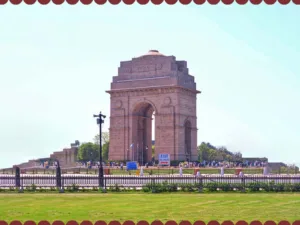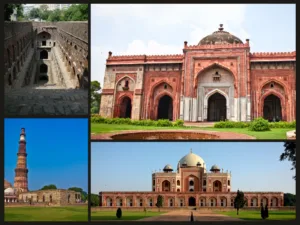Delhi’s India Gate is a famous tourist and hang-out spot for the people of Delhi and tourists. But only a few know that it is actually a war memorial. The India Gate stands tall in the capital city of Delhi to commemorate the Indian soldiers who died in the First World War. It is actually a monument that the British created under their rule.
However, it has become more than a memorial- a place where events of national and international importance occur. Recently, it has become the youth spot, where the youth come to celebrate as well as to protest against something.
Today, we will gain some insights into the cultural and historical importance of Delhi’s India Gate. Also, we will talk about its architecture and other important things.
About Delhi’s India Gate
India Gate was created by the Imperial War graves Commission in December 1918, when India was still in the shackles of the British Government. At that time, it was built as a memorial for the 84000 Indian soldiers who fought for Britain in the First World War. It was also dedicated to the 13000 soldiers who gave up their lives in the Anglo-Afghan War. At that time, they called it the “All India War Memorial,” and the Duke of Connaught laid its foundation stone.

Over time, the importance and the environment around the gate developed more modernistic and contemporary. After the Bangladesh Liberation war in 1972, a structure with a black marble plinth was placed under the gate. Along with it, four reversed rifles, a war helmet, and four eternal flames were built beneath the gate. This structure was named Amar Jawan Jyoti (Flame of the Immortal Soldier).
The India Gate of Delhi is one of the largest war memorials in the country, which is visited by the Prime Minister of India every year on Republic Day to pay tributes to the soldiers. In 2017, another similar gate was built in England, with the name “Arch of Remembrance.”
The Architecture of the Gate
Sir Edwin Lutyens, a member of the Imperial War Graves Commission, designed the memorial gate in 1918. Creators engraved India Gate’s cornice with imperial suns and wrote INDIA in capital letters on the arches on both sides of the gate. The gate stands 42 meters tall on a base of red Bharatpur stone. The complex of the gate is hexagonal in shape and has a diameter of 625 meters.
The India Gate of Delhi is also often compared to the famous Arc de Triomphe in Paris, and it strives for classical simplicity. It is situated on one end of the Rajpath. On the top, the architects created a bowl to light it up on special occasions.
However, with the advent of lights and other decorations, the bowl today feels irrelevant and unnecessary. The flames that were to be on the top of the structure are now over the Amar Jawan Jyoti.
Today, the Gate has been decorated with many other decorations, such as parks, fountains, lighting, etc. In the evening, the area surrounding the gate becomes lit as the fountains nearby rise up in multiple colors. The lush green lawns beside the structure make it an amazing picnic spot.
Other Attractions Near India Gate
The India Gate complex covers not only the tall arch but also many other picture-perfect attractions around it. Some of the prominent places near the gate include-
- Kartavya Path- The Rajpath or recently renamed as the Kartavya Path, is the path or the rod stretching from Rashtrapati Bhavan to India gate. It symbolizes the valor of the army men.
- Statue of Netaji Subhash Chandra Bose- A statue of Netaji Subhash Chandra Bose made of a monolithic block of Black granite stands tall beside the India Gate of Delhi. Architects installed it on a canopy facing the India gate recently.
- Raj Ghat- Not far away from the India Gate is the memorial of Mahatma Gandhi, which is a splendid garden in itself.
- Delhi Food Walks- Coming to Delhi and leaving without trying the famous North Indian delicacies? Not a good idea! Delhi food walks offer an exciting experience to the visitors of India gate. Here, you can eat famous dishes and learn about their importance and history too!

Some Facts About Delhi’s India Gate
The India Gate also has a plethora of facts related to it. It is one of the most significant Indian monuments which people from all over the world come to visit. Some of the interesting things to know about India gate include the following-
- While the construction of the India gate began as early as 1918, the India gate was inaugurated on February 12, 1931, by Viceroy Lord Irwin.
- Since 1971, this monument has been the place to honor all the soldiers in the army who have given up their life for the nation. It is thus known as the tomb of the unknown soldiers, as no one even has a track of the soldiers that lost their lives in the respective wars.
- Every year, the Prime minister comes to pay tributes to all martyrs here, and the Republic Day Parade is initiated from here only.
- The marshals at the Amar Jyoti keep burning day and night to honor the soldiers.
- The walls of the India Gate have engraved on them the names of a lot of soldiers who lost their lives during multiple battles and wars.
- Every day, the top of the gate is illuminated with the Tricolor, and the rest of the gate with normal lights.
- In front of the gate, visitors can find the flags of the Indian Armed Forces- Army, Navy, and Air force.
Final Words
While visiting Delhi, India Gate is a mandatory spot to visit and is a national monument like Rajghat. It fills you with the values of nationality and love for India. The gate screams out the tales of vigor and valor shown by the brave soldiers and inspires us to be good citizens and contribute to the country’s development and well-being. If you have not yet visited India Gate, this is your hint to take a trip to Delhi’s India Gate now!



